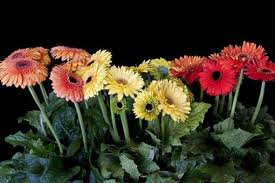Gerbera
|
These herbaceous plants are found in South Africa. The fuzzy leaves grow in a rosette close to the soil and are lance-shaped, deeply lobed and about 12 inches long. During the summer, these plants bear many orange-scarlet flowers that resemble daisies atop a long stalk. There are many hybrids that come in white, cream, yellow, orange-pink, crimson, purple or violet. These plants are usually grown in greenhouses and are used for cut flowers, but in mild climates, they can be cultivated outdoors.
Pot CultivationWhen they are grown in a cool greenhouse, the minimum winter temperature must be 40 degrees. Repotting should be done in April. The compost should consist of equal parts of loam, peat or leaf mold with a liberal amount of sand added. When they've been repotted, be sure to shade and lightly sprits them until they're established, after which no shading is necessary. Throughout the summer, the soil should be kept moist and applications of weak liquid fertilizer should be given once in a while. From November to May, water should be given only when the soil becomes fairly dry. PropagationThe basal shoots can be detached in April and inserted in sandy soil. Keep them in a box covered with glass until they form roots, they can then be potted in 3-inch pots and later, in the 5-inch pots in which they will bear their flowers. Seeds may also be sown in pots of sandy soil in the spring or early summer. The pots are covered with a pane of glass and when the seedlings are an inch tall they are plucked out and placed in deep pans and subsequently into separate pots.
VarietiesG. Jamesonii (This is the main kind that grows 12 in. high and produces orange-scarlet flowers in the summer). |





